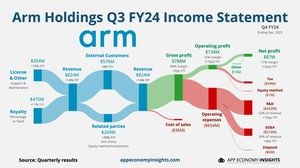The COVID-19 pandemic disrupted lives across the globe, leading to significant challenges, particularly for families facing economic hardships and students adjusting to new modes of learning. Recent studies have explored these impacts, shedding light on how various relief measures have affected low-wage workers and educational systems, particularly focusing on the experiences of families with children.
According to Caitlin E. Caspi and her colleagues at BMC Public Health, the COVID-19 crisis created acute risks for households with children, especially among low-wage employees. The researchers conducted semi-structured interviews with 40 families from two U.S. cities to capture their experiences with economic relief measures implemented during the pandemic.
Economic security emerged as a central theme, linking financial stability to food security, housing stability, and overall well-being. Participants discussed barriers they encountered when trying to access relief measures like Economic Impact Payments and expanded Supplemental Nutrition Assistance Program (SNAP) benefits. Among these barriers were administrative hurdles, lack of accurate information, and complicated application processes.
Interestingly, the study noted some facilitators as well, such as automatic processes for distributing benefits. While many participants appreciated the support they received, sentiments were mixed, often accompanied by concerns over the potential discontinuation of these measures. This reflects the precarious nature of economic stability for low-wage workers during this public health crisis.
Further insights stemmed from another study conducted by Neranjan Senarath and his team on the impact of the pandemic on educational experiences for students from diverse socioeconomic backgrounds in Sri Lanka. Their research revealed how the shift to online learning affected students differently based on their familial income levels.
Through extensive nationwide surveys, the researchers identified seven significant factors influencing students' learning experiences during lockdowns. Notably, high-income students reported being emotionally affected due to the challenges of adapting to remote learning. Conversely, students from low-income households faced more tangible obstacles, primarily related to inadequate resources for online education.
The pandemic hastily transitioned educational systems to online delivery, disrupting traditional structures and posing substantial challenges, particularly for marginalized communities. The closure of schools not only stripped children of academic environments but also excluded them from supportive services like meals and healthcare, which schools often provide.
Besides the impacts on families and students, the pandemic also elicited trends within educational institutions, as seen with Oregon's rise in college enrollment. Data from the state's Higher Education Coordinatin Commission noted a 3% enrollment increase across public colleges and universities this fall, indicating some recovery as institutions adapt to the post-pandemic educational environment.
Many community colleges, significantly impacted during the pandemic, reported even higher enrollment increases of about 4.3%. This is welcome news for educators and policymakers who are concerned about educational access and equity.
Ben Cannon, the director of the Oregon Higher Education Coordinatin Commission, expressed optimism about the enrollment trends, labeling the report as “really encouraging.” Such patterns reflect not only the resilience of educational institutions but also the determination of students to pursue their goals even amid challenging circumstances.
These studies highlight the importance of recognizing both the barriers and facilitators to accessing resources during the pandemic, which informed policies during the crisis and can guide future response efforts for similar emergencies.
Strategies like improving access to information about benefits and streamlining enrollment processes can bolster support for low-wage families, ensuring they receive the assistance they need when faced with economic instability.
Overall, the intersection of economic relief measures and changes to educational systems during the pandemic paints a complex picture. Challenges remain, particularly for economically vulnerable populations, highlighting the need for continued vigilance and adaptive strategies as communities work toward recovery.
While the pandemic may have disrupted various aspects of life, it also sets the stage for important lessons learned about ensuring equity and access across different sectors, particularly education and economic support.



